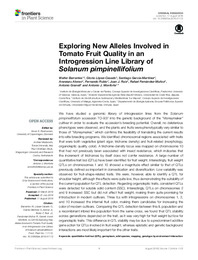Por favor, use este identificador para citar o enlazar este ítem:
https://hdl.handle.net/11000/36015Registro completo de metadatos
| Campo DC | Valor | Lengua/Idioma |
|---|---|---|
| dc.contributor.author | García Martínez, Santiago | - |
| dc.contributor.author | Barrantes, Walter Alejandro | - |
| dc.contributor.author | López Casado, Gloria María | - |
| dc.contributor.author | Alonso Sanchis, Aránzazu | - |
| dc.contributor.author | Rubio, Fernando | - |
| dc.contributor.author | Ruíz, Juan José | - |
| dc.contributor.author | Fernández Muñoz, Rafael | - |
| dc.contributor.author | Granell, Antonio | - |
| dc.contributor.author | MONFORTE, Antonio José | - |
| dc.contributor.other | Departamentos de la UMH::Biología Aplicada | es_ES |
| dc.date.accessioned | 2025-03-17T13:27:22Z | - |
| dc.date.available | 2025-03-17T13:27:22Z | - |
| dc.date.created | 2016 | - |
| dc.identifier.citation | Front. Plant Sci., 17 August 2016 Sec. Plant Breeding Volume 7 - 2016 | es_ES |
| dc.identifier.issn | 1664-462X | - |
| dc.identifier.uri | https://hdl.handle.net/11000/36015 | - |
| dc.description.abstract | We have studied a genomic library of introgression lines from the Solanum pimpinellifolium accession TO-937 into the genetic background of the “Moneymaker” cultivar in order to evaluate the accession’s breeding potential. Overall, no deleterious phenotypes were observed, and the plants and fruits were phenotypically very similar to those of “Moneymaker,” which confirms the feasibility of translating the current results into elite breeding programs. We identified chromosomal regions associated with traits that were both vegetative (plant vigor, trichome density) and fruit-related (morphology, organoleptic quality, color). A trichome-density locus was mapped on chromosome 10 that had not previously been associated with insect resistance, which indicates that the increment of trichomes by itself does not confer resistance. A large number of quantitative trait loci (QTLs) have been identified for fruit weight. Interestingly, fruit weight QTLs on chromosomes 1 and 10 showed a magnitude effect similar to that of QTLs previously defined as important in domestication and diversification. Low variability was observed for fruit-shape-related traits. We were, however, able to identify a QTL for shoulder height, although the effects were quite low, thus demonstrating the suitability of the current population for QTL detection. Regarding organoleptic traits, consistent QTLs were detected for soluble solid content (SSC). Interestingly, QTLs on chromosomes 2 and 9 increased SSC but did not affect fruit weight, making them quite promising for introduction in modern cultivars. Three ILs with introgressions on chromosomes 1, 2, and 10 increased the internal fruit color, making them candidates for increasing the color of modern cultivars. Comparing the QTL detection between this IL population and a recombinant inbred line population from the same cross, we found that QTL stability across generations depended on the trait, as it was very high for fruit weight but low for organoleptic traits. This difference in QTL stability may be due to a predominant additive gene action for QTLs involved in fruit weight, whereas epistatic and genetic background interactions are most likely important for the other traits. | es_ES |
| dc.format | application/pdf | es_ES |
| dc.format.extent | 12 | es_ES |
| dc.language.iso | eng | es_ES |
| dc.publisher | Frontiers Media | es_ES |
| dc.rights | info:eu-repo/semantics/openAccess | es_ES |
| dc.rights | Attribution-NonCommercial-NoDerivatives 4.0 Internacional | * |
| dc.rights.uri | http://creativecommons.org/licenses/by-nc-nd/4.0/ | * |
| dc.subject | quantitative trait loci (QTL) | es_ES |
| dc.subject | germplasm | es_ES |
| dc.subject | wild species | es_ES |
| dc.subject | mapping | es_ES |
| dc.subject | genotype by environment interaction | es_ES |
| dc.title | Exploring New Alleles Involved in Tomato Fruit Quality in an Introgression Line Library of Solanum pimpinellifolium | es_ES |
| dc.type | info:eu-repo/semantics/article | es_ES |
| dc.relation.publisherversion | https://doi.org/10.3389/fpls.2016.01172 | es_ES |

Ver/Abrir:
Frontiers on line.pdf
1,45 MB
Adobe PDF
Compartir:
 La licencia se describe como: Atribución-NonComercial-NoDerivada 4.0 Internacional.
La licencia se describe como: Atribución-NonComercial-NoDerivada 4.0 Internacional.
.png)